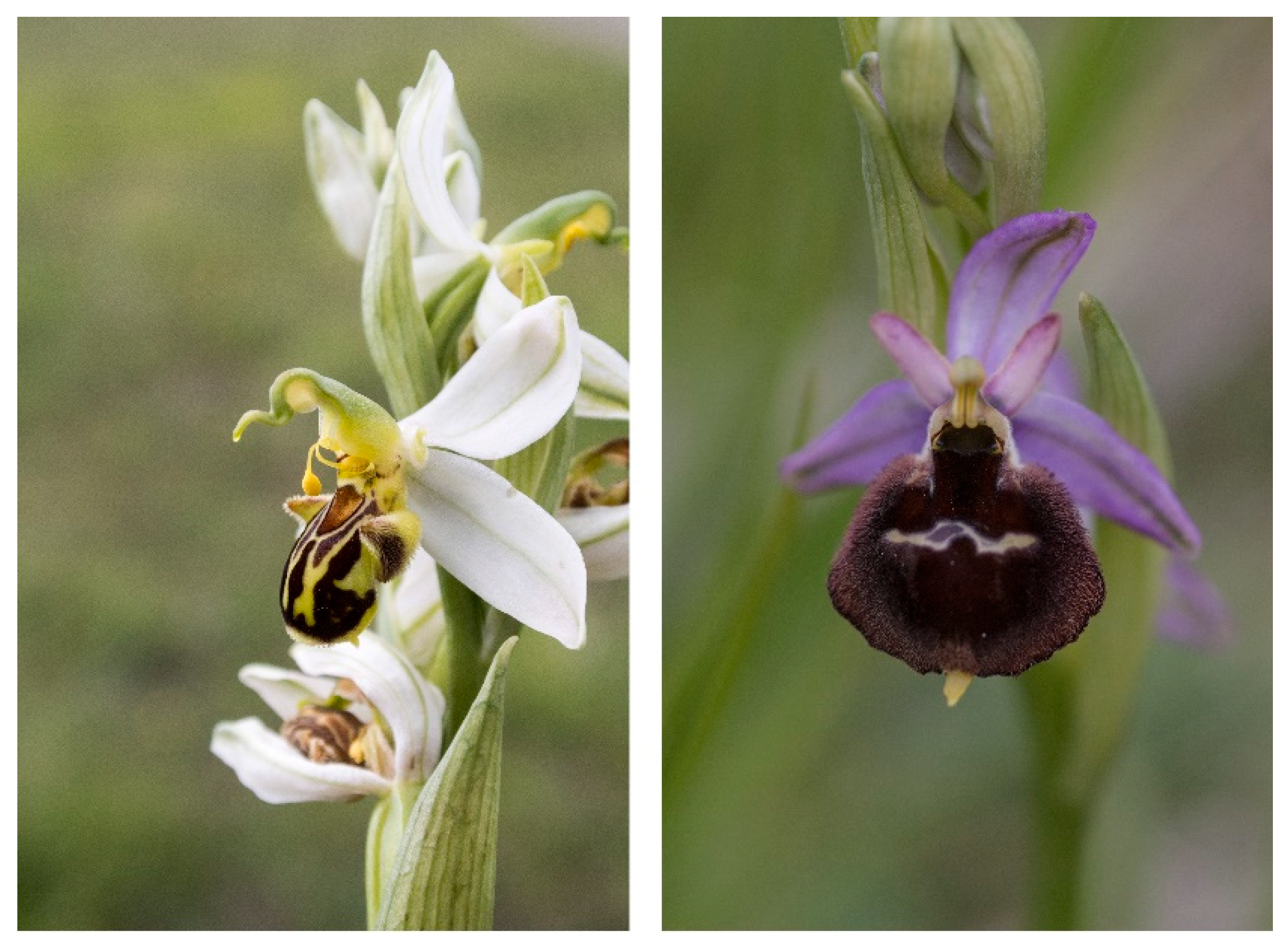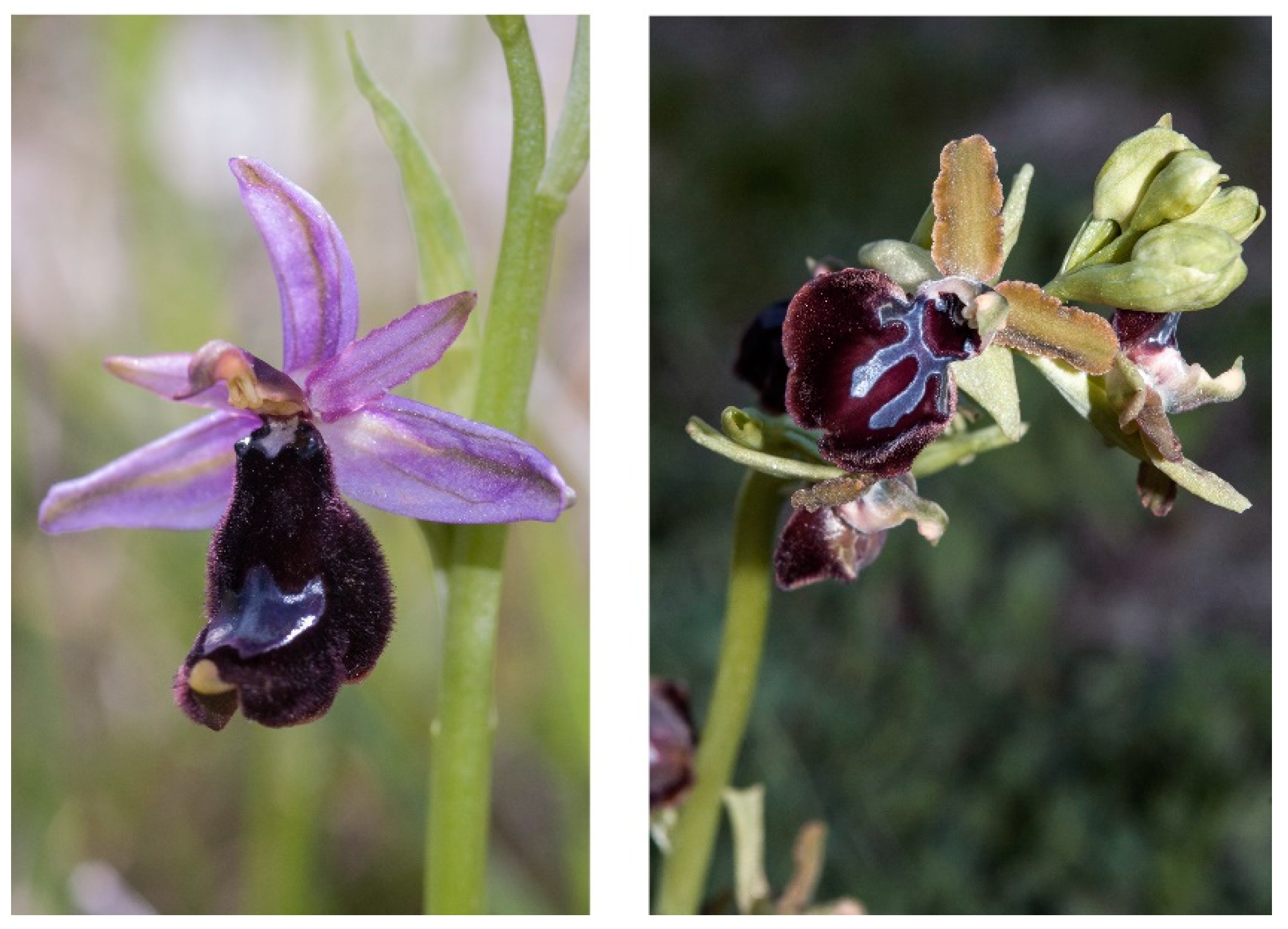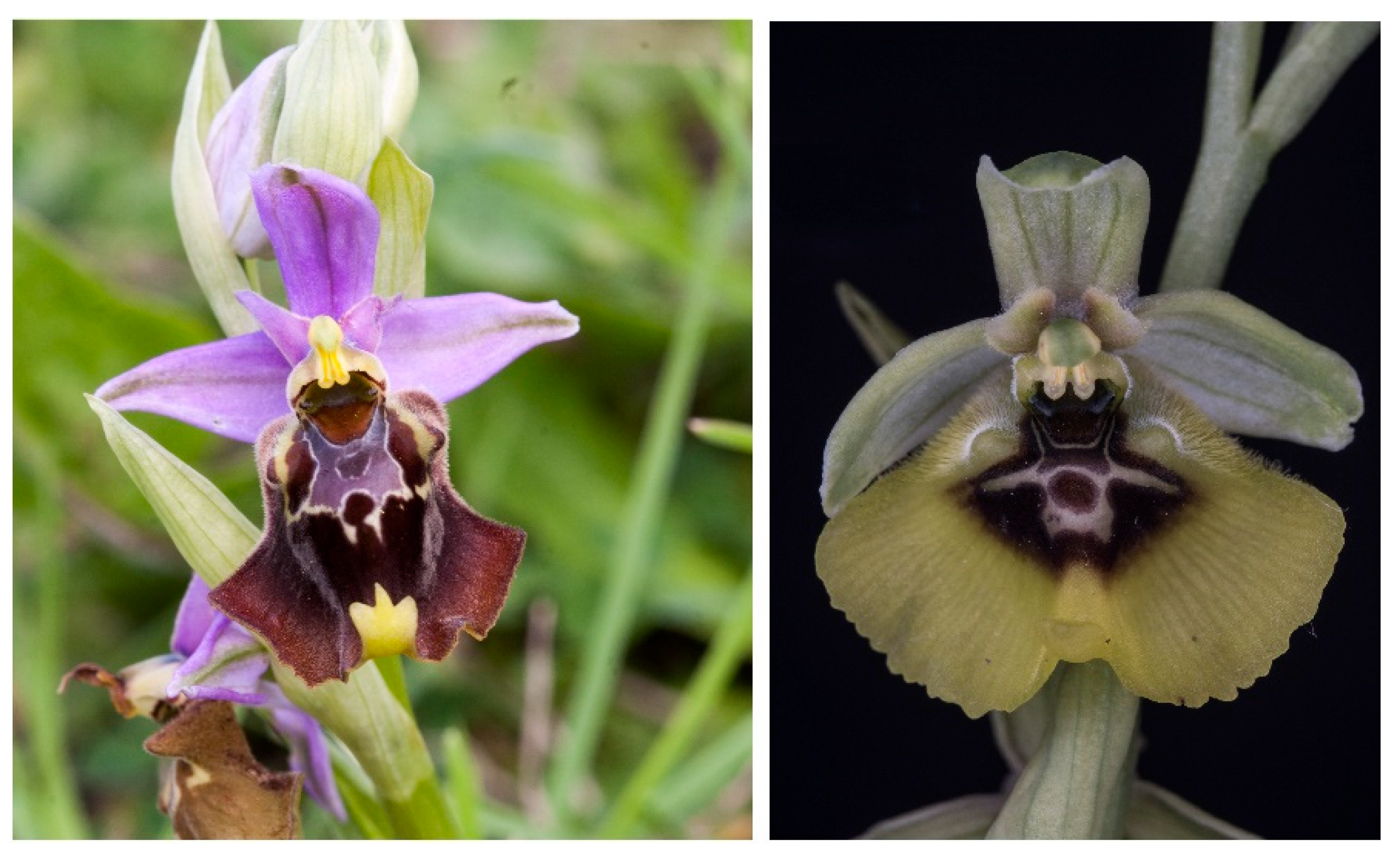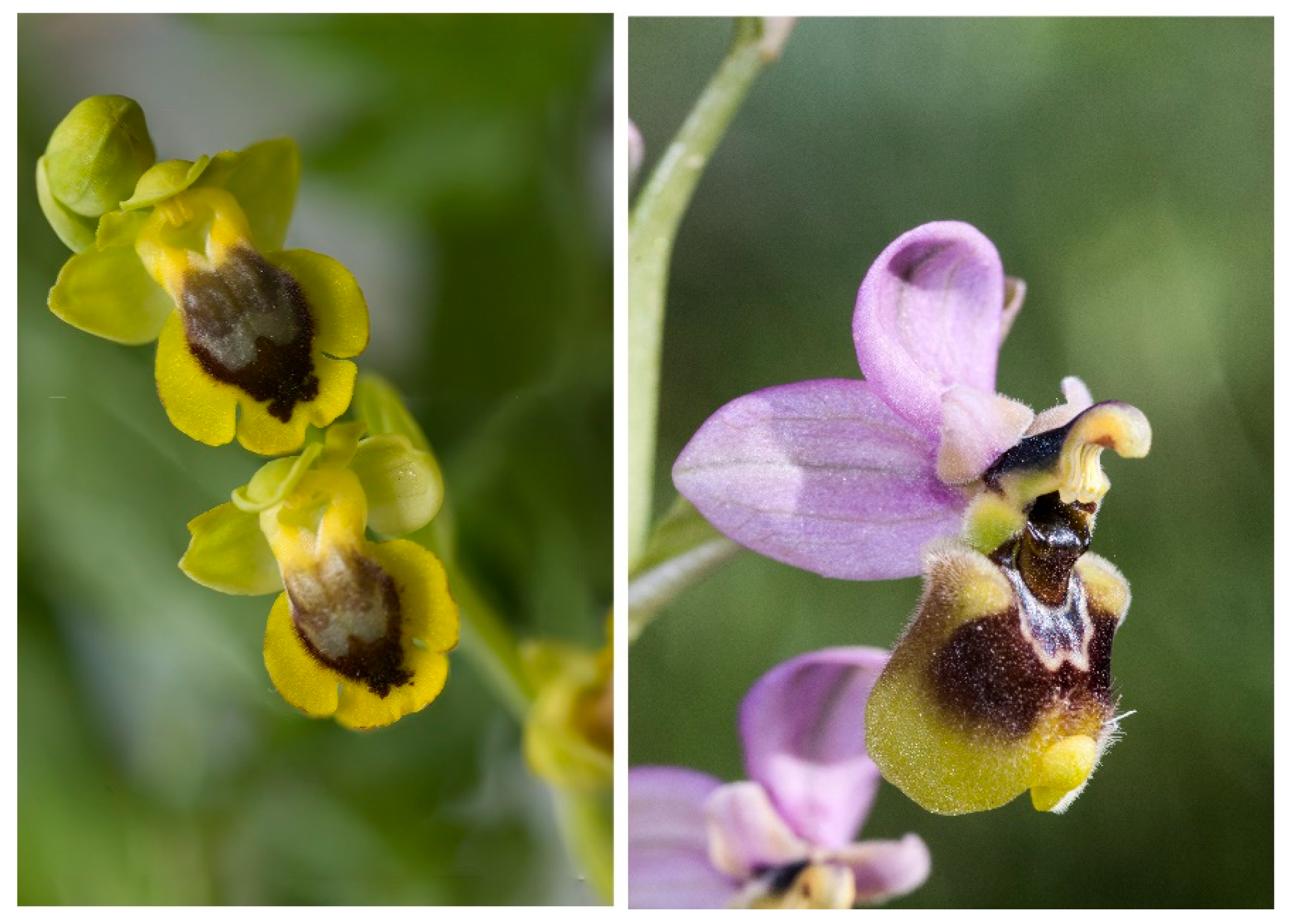Preprint
Article
Composition of the Scent in Some Ophrys Orchids Growing in Basilicata (Southern Italy). A Solid Phase Microextration Study Coupled with Gas Chromatography and Mass Spectrometry
Altmetrics
Downloads
103
Views
31
Comments
0
A peer-reviewed article of this preprint also exists.
This version is not peer-reviewed
Submitted:
08 October 2023
Posted:
09 October 2023
You are already at the latest version
Alerts
Abstract
SPME analysis of the scent Ophrys orchids gave the following results: O. apifera: benzyl benzoate, -copaene, caryophyllene, and cyclosativene. O. crabronifera subsp. biscutella: pentadecene, pentadecane, heptadecane, nonadecane, and heinecosane. O. bertolonii subsp. bertolonii: pentadecane, heptadecane and nonadecane. O. passionis subsp. garganica: i-propyl palmitate, caryophyllene, pentadecane, and heptadecane. O. holosericea subsp. apulica: -copaene, pentadecane, caryophyllene, and heptadecane. O. lacaitae: -copaene, pentadecane, heptadecane, and caryophyllene. O. bombyliflora: cyclosativene, pentadecane, and ethyl dodecanoate. O. insectifera: 8-heptadecene, pentadecane, and heptadecane. O. lutea: heptadecane, 8-heptadecene, nonadecane, and docosane. O. tenthredinifera subsp. neglecta: -copaene, caryophyllene, and i-propyl palmitate.
Keywords:
Subject: Chemistry and Materials Science - Organic Chemistry
1. Introduction
Some years ago, we started a systematic study of the scent of spontaneous orchid species growing in Basilicata (Southern Italy). The aim of this study was to create a homogeneous picture of the composition of the aroma of these species using the same methodology for all the species. In particular, we decided to use solid phase microextration (SPME) [1]. This study allowed us to identify the components of the scent of Platanthera bifolia subsp. osca [2], Platanthera chlorantha [3], Cephalanthera orchids [4], Orchis [5], Serapias [6], Himantoglossum [7]. Barlia robertiana [8], Dactylorhiza [9], Gymnadenia [10], Neotinea [11], and Anacamptis orchids [12].
In this work, the scents emitted by ten species of spontaneous orchids growing in Basilicata (Italy) belonging to the Ophrys genus have been determined. They are distributed between the two subgenera Fuciflorae and Ophrys and belonging to different sections and subsections (O. apifera Huds. 1762, O. bertolonii subsp. bertolonii Moretti 1823, O. crabronifera subsp. biscutella (O. Danesch & E. Danesch) Klaver & Kreutz 2013, O. bombyliflora Link (1779) 1800, O. holosericea subsp. apulica (O. Danesch & E. Danesch) Buttler 1986, O. insectifera L. 1753, O. lacaitae Lojac. 1909, O. lutea subsp. lutea Cav. 1793, O. passionis subsp. garganica (E. Nelson) H. Baumann & R. Lorenz 2005, O. tenthredinifera subsp. neglecta (Parl.) E. G. Camus, Bergon & A. Camus 1908 (Table 1 and Figure 1, Figure 2, Figure 3, Figure 4 and Figure 5).
It is known that Ophrys flowers imitate the mating signals of some insect species and are pollinated by sexually excited males who mistake the flower for a female of the same species and pollinate it during a “pseudocopulation”.
Sexually deceptive orchids are unique in their exclusive and effective use of male insects, primarily aculeate Hymenoptera, but also other Hymenoptera and some Diptera [14].
In most European Ophrys species studied so far, male copulation attempts can only be elicited by a scent identical to the female sex pheromone of the pollinating species, substances inducing pseudocopulation however are extractable longchain alkanes/alkenes, visual cues appear to be less important [15].
Often the differences in odor between similar orchid species are small. Small variations have been found between the bouquets of Ophrys fusca and O. bilunulata, as well as between the similar O. sphegodes and O. exaltata [15,16].
Sexually deceptive orchid species typically exploit one or a few specific species of pollinators and may have different pollinators in different regions. A single insect species can also pollinate more than one sexually deceptive orchid species in different regions [16].
All the species examined in this work are sexually deceptive with the sole exception of O. apifera, which is notoriously an autogamous (self-pollinating) species.
With this work we wanted to test, with a rapid method (SPME), species belonging to different sections and subsections of the Ophrys genus in order to verify whether the scent they emit is very similar or different within the different groups they belong to.
The scent of Ophys orchids has been extensively studied. Most of the studies has been performed through the identification of the components of the extracts of labella. Thus, O. insectifera showed the presence as main components of pentacosane, tetracosane, nonanoic acid and nonanal, in a study of 1987 [17], and tricosene, pentacosane, 9-heptacosene, and 9-nonacosene, in a study of 2017 [18]. However, the absorption of the scent of O. insectifera subsp. insectifera on Porapak Q showed as main components pentadecane, heptadecane, and cyclosativene [19], then alkanes with a lower molecular weight than those determined in the other studies on the orchids, and a terpene. In the scent of O. sphegodes pentacosane and tricosane were found in labella extracts [20], while tricosane, pentacosane, and p-cresol were the main components of the scent obtained by steam distillation of the flowers [21]. The scent of O. lupercalis and O. iricolor was due to the presence of tricosane, pentacosane and heptacosane [22]. Together with the same compounds, nonanal was found in O. lupercalis, O. bilunulata, and O. fabrella [23]. SPE collection of the scent of O. normanii showed the presence of octadecanal, tricosane, tricosene, and pentacosene [24]. SPE absororption of the scent of O. apifera showed the presence of butanol, butyl ether, and caryophyllene [25]. Pentacosene and tricosene were found in the labella extracts of O. holosericea [26], while nonanal was the main component of the scent of O. lutea [27]. These studies showed that the extraction of the labella leads to the identification of high molecular weight alkanes and alkenes as the main components of the aroma of these orchids. However, when SPME was used to determine the composition of the scent of O. bertolonii subsp. benacensis 4-methyl tetradecane, nonanal, decanal, dodecanal, 3,5-octadiene-2-one, and caryophyllene were found as the main components of the aroma [28].
2. Materials and Methods
2.1. Plant Material
The sample of O. apifera was collected at Piani del Mattino (PZ), on June 8, 2017. The sample of O. crabronifera subsp. biscutella was collected at Valico Faggeto in the municipality of Moliterno (PZ), on March 11, 2018. The sample of O. bertolonii subsp. bertolonii was collected at Monte Grosse (PZ), on April 18, 2018. The sample of O. bombyliflora was collected at Contrada Macchia Orsino in the municipality of Tolve, on April 9, 2018. The sample of O. holosericea subsp. apulica was collected at Scalo di Grassano, on April 19, 2018. The sample of O. insectifera was collected at Monte Zaccana in the municipality of Castelluccio Superiore, on May 2, 2018. The sample of O. lacaitae was collected at Contrada l’Aia Antica in the municipality of Calvello, on June 6, 2018. The sample of O. lutea subsp. lutea was collected at Scalo di Albano, on April 11, 2018. The sample of O. passionis subsp. garganica was collected at Scalo di Campomaggiore, on April 16, 2018. The sample of O. tenthredinifera subsp. neglecta was collected at Torrente Serrapotomo in the municipality of Laurenzana, on April 8, 2018. The plants were collected by Vito Antonio Romano.
The plants were harvested taking all the clod of earth, taking care not to damage the root system. All the plants had closed flowers to avoid using flowers that were already fertilized but not visible because they were at the beginning of fertilization. The plants were planted in special pots in the greenhouse of the University of Basilicata (Potenza 650 m. a.s.l.), in closed boxes with transparent cloth to avoid fertilization (even if occasional). The correct classification of the species was carried out on flowering plants. The plants were tested when the flowers were all open except the last two.
The plants were tested, whole without being damaged, under a cylindrical glass bell (12cm x 45cm) in which only the inflorescence and the SPME probe are inserted.
To avoid contamination, the interior of the bell was isolated from the external environment with appropriate closing and sealing systems during the 24 hours of the test (from eight in the morning to 8 the following day).
In order to be sure that the internal environment of the bell was isolated from the external environment, various blank tests were carried out.
After the tests the plants remained closed in the boxes to verify that at the end of flowering there were no fertile ovaries and for this reason no herbarium samples were taken. The earthen bread with the bulbs were brought back to the site.
In view of the fact that the investigated taxa are rare wild plants, in order to preserve the species, we have chosen to use a single plant for our analysis.
2.2. Analysis of Volatile Organic Compounds
The SPME analysis of ten different samples of Ophrys has been performed. This way, the identified plants were collected and inserted in glass jar for 24 h where was present also the fiber (DVB/CAR/PDMS) of and SPME syringe. After this time the fiber was desorbed in a gas chromatographic apparatus equipped with a quadrupole mass spectrometer detector. A 50/30-μm DVB/CAR/PDMS module with 1 cm fiber (57328-U, Supelco, Milan, Italy) was employed to determine VOCs. SPME fiber was maintained in the bell jar for 24 h. The analytes were desorbed in the splitless injector at 250 °C for 2 min. Analyses were accomplished with an HP 6890 Plus gas chromatograph equipped with a Phenomenex Zebron ZB-5 MS capillary column (30-m × 0.25-mm i.d. × 0.25 μm FT) (Agilent, Milan, Italy). An HP 5973 mass selective detector in the range 0-800 m/z (Agilent) was utilized with helium at 0.8 mL/min as the carrier gas. The EI source was used at 70 eV. The analyses were performed by using a splitless injector. The splitless injector was maintained at 250 °C and the detector at 230 °C. The oven was held at 40 °C for 2 min, then gradually warmed, 8 °C/min, up to 250 °C and held for 10 min. Tentatively identification of aroma components was based on mass spectra and Wiley 11 and NIST 14 library comparison. Single VOC peak was considered as identified when its experimental spectrum matched with a score over 90% that present in the library. All the analyses were performed in triplicate.
3. Results and Discussion
The SPME-GC-MS analysis of Orphys samples gave the results reported in Table 2. The main component of the scent of O. apifera was benzyl benzoate (22.52%), while other important components were a-copaene (9.11%), caryophyllene (8.07%), and cyclosativene (6.97%) (Table 2). It is noteworthy the significant difference in the scent in comparison with that obtained by using SPE absorption. In that case, butanol, butyl ether, and caryophyllene were the main components of the aroma [25,29]. The observed difference can be due to the different analyzed species, to the different harvesting places (Basilicata and Catalonia), to different pollinator insects, to the different analytical procedures.
The analysis of the scent of O. crabronifera subsp. biscutella showed that the aroma is mainly due to the presence hydrocarbon compounds, as in several species as reported above. However, we found the presence of pentadecene (6.43%), pentadecane (8.06%), heptadecane (8.37%), nonadecane (8.18%), and heinecosane (5,12%). Furthermore, i-propyl palmitate was detected in a relevant amoun (5.06%) (Table 2). In other Ophrys species, the scent analysis performed through the labella extraction gave high molecular weight hydrocarbons (higher than thirty carbon atoms), while, in our determination, the main component of the scent has seventeen carbon atoms. Unfortunately, other analyses of the same species are not available.
The scent of O. bertolonii subsp. bertolonii gave a similar result. The main component was pentadecane (28.62%), while other significant compounds were heptadecane (7.23%) and nonadecane (6.30%). Also in this case, a significant difference has been observed considering the results obtained in the SPME analysis of O. bertolonii subsp. benacensis [28]. The observed differences can be due to the different subspecies, to the different harvesting places (Basilicata and Lecco), or to different pollinators.
When a sample of O. passionis subsp. garganica was analyzed the main component of the scent was i-propyl palmitate (29.62%), while other components were caryophyllene (8.34%), pentadecane (8.69%), and heptadecane (9.22%). In this case, this is the first reported analysis of this species. In the case of O. holosericea subsp. apulica the main component were a-copaene (11.30%) and pentadecane (11.48%), while other compound found in the scent were caryophyllene (7.90%), and heptadecane (8.15%). The analysis of labella extracts gave some alkenes as main components of the scent [26]. In this case the different analytical procedure is responsible for the observed differences.
The same trend was observed in the analysis of O. lacaitae: the main components were a-copaene (12.08%), pentadecane (13.40%), and heptadecane (14.43%), while caryophyllene was found in relevant amount (6.68%).
The scent of O. bombyliflora showed the presence of cyclosativene (10.09%), pentadecane (10.33%), and ethyl dodecanoate (9.46%). The analysis of the scent of O. insectifera gave the following results: the main component was 8-heptadecene (18.88%) followed by pentadecane (13.73%), and heptadecane (7.98%). Previous results, obtained on labella extracts, showed the presence of high molecular weight compounds [17,18]. On the contrary, the compounds detected through absorption on Porapak Q are quite similar, with the difference of caryophyllene, to the results presented here [19]. We have to note, finally, that all the high molecular weight hydrocarbons detected in the labella are solid and it is very difficult that they could be present in the scent.
Nonanal was the compound detected in a previous work in O. lutea [27]. SPME analysis showed the presence of heptadecane (39.37%), 8-heptadecene (7.25%), nonadecane (8.87%), and docosane (9.94%). This result is consistent with the trend of SPME analysis on Ophrys orchids, where, with some differences for different orchid species, the compounds we detected were very similar. The difference with previous results can depend on the analytical procedure. Finally, the scent of O. tenthredinifera subsp. neglecta has as components a-copaene (11.61%), caryophyllene (11.73%), and i-propyl palmitate (14.73%), showing that is another case, beyond O. apifera where hydrocarbons are not present in relevant amount in the scent.
4. Conclusions
In this article we have determined the composition of the aroma of some orchids belonging to the Ophrys genus. This result was obtained using SPME coupled with GC-MS as an analysis technique. In the ten samples analyzed, 62 compounds were found; however, the compounds present in greater quantities are almost always the same, with variations (sometimes substantial) between species. It is important to note that there is never any correspondence between our analyzes and those obtained through chemical extraction of plant labels. In this case, high molecular weight hydrocarbons are always recovered, which, however, can hardly be constituents of any aroma, being solid compounds with a low vapor pressure.
Author Contributions
Conceptualization, M.D. and V.A.R.; investigation, M.M. and R.R.; data curation, R.L. All authors have read and agreed to the published version of the manuscript.
Funding
This research received no external funding.
Conflicts of Interest
The authors declare no conflict of interest.
References
- Pawliszyn, J. Applications of Solid Phase Microextraction; Royal Society of Chemistry: London, UK, 1999. [Google Scholar]
- D’Auria, M.; Lorenz, R.; Racioppi, R.; Romano, V. A. Fragrance components of Platanthera bifolia subsp. osca. Nat. Prod. Res. 2017, 31, 1612–1619. [Google Scholar] [CrossRef] [PubMed]
- D’Auria, M.; Lorenz, R.; Mecca, M.; Racioppi, R.; Romano, V. A.; Viggiani, L. Fragrance components of Platanthera bifolia subsp. osca and Platanthera chlorantha collected in several sites in Italy. Nat. Prod. Res. 2020, 34, 2857–2861. [Google Scholar] [CrossRef] [PubMed]
- D’Auria, M.; Lorenz, R.; Mecca, M.; Racioppi, R.; Romano, V. A. Aroma components of Cephalanthera orchids. Nat. Prod. Res. 2021, 35, 174–177. [Google Scholar] [CrossRef]
- Mecca, M.; Racioppi, R.; Romano, V. A.; Viggiani, L.; Lorenz, R.; D’Auria, M. Volatile organic compounds from Orchis species found in Basilicata (Southern Italy). Compounds 2021, 1, 83–93. [Google Scholar] [CrossRef]
- D’Auria, M.; Lorenz, R.; Mecca, M.; Racioppi, R.; Romano, V. A. The composition of the aroma of Serapias orchids in Basilicata (Southern Italy). Nat. Prod. Res. 2021, 35, 4068–4072. [Google Scholar] [CrossRef] [PubMed]
- Mecca, M.; Racioppi, R.; Romano, V. A.; Viggiani, L.; Lorenz, R.; D’Auria, M. The scent of Himantoglossum species found in Basilicata (Southern Italy). Compounds 2021, 1, 164–173. [Google Scholar] [CrossRef]
- Romano, V. A.; Rosati, L.; Fascetti, S.; Cittadini, A. M. R.; Racioppi, R.; Lorenz, R.; D’Auria, M. Spatial and temporal Variability of the floral scent emitted by Barlia robertiana (Loisel.) Greuter, a Mediterranean food-deceptive orchid. Compounds 2022, 2, 37–53. [Google Scholar] [CrossRef]
- Mecca, M.; Racioppi, R.; Romano, V. A.; Viggiani, L.; Lorenz, R.; D’Auria, M. Volatile organic compounds in Dactylorhiza species. Compounds 2022, 2, 121–130. [Google Scholar] [CrossRef]
- D’Auria, M.; Lorenz, R.; Mecca, M.; Racioppi, R.; Romano, V. A.; Viggiani, L. Fragrance components of Gymnadenia conopsea and Gymnadenia odoratissima collected at several sites in Italy and Germany. Nat. Prod. Res. 2022, 36, 3435–3439. [Google Scholar] [CrossRef]
- D’Auria, M.; Lorenz, R.; Mecca, M.; Racioppi, R.; Romano, V. A.; Viggiani, L. The scent of Neotinea orchids from Basilicata (Southern Italy). Nat. Prod. Res. 2022, 36, 3741–3743. [Google Scholar] [CrossRef]
- D’Auria, M.; Emanuele, L.; Lorenz, R.; Mecca, M.; Racioppi, R.; Romano, V. A.; Viggiani, L. HS-SPME-GC-MS determination of the scent of Anacamptis taxa (fam. Orchidaceae) from Basilicata (Southern Italy). Nat. Prod. Res. [CrossRef] [PubMed]
- GIROS. Orchidee d’Italia. Guida alle orchidee spontanee; Il Castello: Milan, Italy, 2016. [Google Scholar]
- Schiestl, F. P. On the success of a swindle: pollination by deception in. orchids. Sci. Nat. 2005, 92, 255–264. [Google Scholar] [CrossRef] [PubMed]
- Ayasse, M.; Stökl, J.; Francke, W. Chemical ecology and pollinator-driven speciation in sexually deceptive orchids. Phytochemistry 2011, 72, 1667–1677. [Google Scholar] [CrossRef] [PubMed]
- Gaskett, A.C. Orchid pollination by sexual deception: pollinator perspectives. Biol. Rev. 2011, 86, 33–75. [Google Scholar] [CrossRef] [PubMed]
- Borg-Karlson, A.-K.; Bergström, G.; Kullenberg, B. Chemical basis for the relationship between Ophrys orchids and their pollinators. I. Volatile compounds of O. insectifera and O. speculum as insect mimetic attractans/excitans. Chemica Scripta 1987, 27, 303–311. [Google Scholar]
- Gervasi, D. D. L.; Selosse, M.-A.; Sauve, M.; Francke, W.; Vereecken, N. J.; Cozzolino, S.; Schiestl, F. P. Floral scent and species divergence in a pair of sexually deceptive orchids. Ecol. Evol. 2017, 7, 6023–6034. [Google Scholar] [CrossRef] [PubMed]
- Borg-Karlson, A.-K.; Growth, I.; Ågren, L.; Kullenberd, B. Form-specific fragances from Ophrys insectifera L. (Orchidaceae) attract species of different pollinator genera. Evidence of sympatric speciation? Chemoecology 1993, 4, 39–45. [Google Scholar] [CrossRef]
- Ayasse, M.; Schiestl, F. P.; Paulus, H. F.; Löfstedt, C.; Hansson, B.; Ibarra, F.; Francke, W. Evolution of reproductive strategies in the sexually deceptive orchid Ophrys sphegodes: how does flower -specific variation of odor signals influence reproductive success? Evolution 2000, 54, 1995–2006. [Google Scholar]
- Robustelli della Cuna, F. S.; Cortis, P.; Esposito, F.; De Agostini, A.; Sottani, C.; Sanna, C. Chemical composition of essential oil from four sympatric orchids in NW-Italy. Plants 2022, 11, 826. [Google Scholar] [CrossRef]
- Stökl, J.; Schlüter, P. M.; Stuessy, T. F.; Paulus, H. F.; Assum, G.; Ayasse, M. Scent variation and hybridization cause the displacement of a sexually deceptive orchid species. Am. J. Bot. 2008, 95, 472–481. [Google Scholar] [CrossRef]
- Stökl, J.; Schlüter, P. M.; Stuessy, T. F.; Paulus, H. F.; Fraberger, R.; Erdmann, D.; Schulz, C.; Francke, W.; Assum, G.; Ayasse, M. Speciation in sexually deceptive orchids: pollinator-driven selection maintains discrete odour phenotypes in hybridizing species. Biol. J. Linnean Soc. 2009, 98, 439–451. [Google Scholar] [CrossRef]
- Gögler, J.; Stökl, J.; Sramkova, A.; Twele, R.; Francke, W.; Cozzolino, S.; Cortis, P.; Scrugli, A.; Ayasse, M. Ménage à trois – two endemic species of deceptive orchids and one pollinator species. Evolution 2009, 63, 2222–2234. [Google Scholar] [CrossRef] [PubMed]
- Gallego, E.; Gelabert, A.; Roca, F. J.; Perales, J. F.; Guardino, X. Identification of volatile organic compounds (VOC) emitted from three European orchid species with different pollination strategies: two deceptive orchids (Himantoglossum robertianum and Ophrys apifera) and rewardin orchid (Gymnadenia conopsea). J. Biodiv. Environ. Sci. 2012, 2, 18–29. [Google Scholar]
- Robustelli della Cuna, F. S.; Calevo, J.; Bari, E.; Giovannini, A.; Boselli, C.; Tava, A. Characterization and antioxidant activity of essential oil of four sympatric orchid species. Molecules 2019, 24, 3878. [Google Scholar] [CrossRef] [PubMed]
- Borg-Karlson, A.-K.; Bergström, G.; Growth, I. Chemical basis for the relationship between Ophrys orchids and their pollinators. I. Volatile compounds of Ophrys lutea and O. fusca as insect mimetic attractants/excitants. Chemica Scripta 1985, 25, 283–294. [Google Scholar]
- Manzo, A.; Panseri, S.; Vagge, I.; Giorgi, A. Volatile fingerprint of Italian population of orchids using solid phase microextraction and gas chromatography coupled with mass spectrometry. Molecules 2014, 19, 7913–7936. [Google Scholar] [CrossRef] [PubMed]
- Borg-Karlson, A.-K. Chemical and ethological studies of pollination in the genus Ophrys (Orchidaceae). Phytochemistry 1990, 29, 1359–1387. [Google Scholar] [CrossRef]
Figure 1.
Ophrys apifera (left); Ophrys crabronifera subsp. biscutella (right) (Photos of V.A.R.).

Figure 2.
Ophrys bertolonii subsp. bertolonii (left); Ophrys passionis subsp. garganica (right) (Photos of V.A.R.).
Figure 2.
Ophrys bertolonii subsp. bertolonii (left); Ophrys passionis subsp. garganica (right) (Photos of V.A.R.).

Figure 3.
Ophrys holosericea subsp. apulica (left); Ophrys lacaitae (right) (Photos of V.A.R.).

Figure 4.
Ophrys bombyliflora (left); Ophrys insectifera (right) (Photos of V.A.R.).

Figure 5.
Ophrys lutea subsp. lutea (left); Ophrys tenthredinifera subsp. neglecta (right) (Photos of V.A.R.).
Figure 5.
Ophrys lutea subsp. lutea (left); Ophrys tenthredinifera subsp. neglecta (right) (Photos of V.A.R.).

Table 1.
Taxonomic identification of the species utilized in this study. The nomenclature has been referred to [13].
Table 1.
Taxonomic identification of the species utilized in this study. The nomenclature has been referred to [13].
| Species | Subgenus | Section | Subsection |
|---|---|---|---|
| O. apifera | Fuciflorae | Apiferae | |
| O. crabronifera subsp. biscutella | Fuciflorae | Araniferae | Sphegodes |
| O. bertolonii subsp. bertolonii | Fuciflorae | Araniferae | Bertoloniorum |
| O. passionis subsp. garganica | Fuciflorae | Araniferae | Sphegodes |
| O. holosericea subsp. apulica | Fuciflorae | Fuciflorae | |
| O. lacaitae | Fuciflorae | Fuciflorae | |
| O. bombyliflora | Ophrys | Bomyliflorae | |
| O. insectifera | Ophrys | Ophrys | |
| O. lutea subsp. lutea | Ophrys | Pseudophrys | Fusci-luteae |
| O. tenthredinifera subsp. neglecta | Ophrys | Tenthrediniferae |
Table 2.
Volatile organic compounds detected by using SPME-GC-MS in Ophrys species.
| Compound | r.t. [min.] | KI | Area % ± 0.03 | |||||||||
|---|---|---|---|---|---|---|---|---|---|---|---|---|
| Ophrys | ||||||||||||
| apifera | crabronifera subsp. biscutella | bertolonii subsp. bertolonii | passionis subsp. garganica | holosericea subsp. apulica | lacaitae | bombyliflora | insectifera | lutea subsp. lutea | tenthredinifera subsp. neglecta | |||
| Octanol | 10.82 | 1072 | 4.69 | |||||||||
| Undecane | 11.31 | 1100 | 1.05 | |||||||||
| Decanal | 13.17 | 1195 | 0.70 | 0.74 | 0.48 | |||||||
| Dodecane | 13.27 | 1200 | 0.58 | 0.45 | 0.53 | |||||||
| Nonanoic acid | 14.38 | 1272 | 2.00 | |||||||||
| Isobornyl acetate | 14.97 | 1285 | 1.65 | 0.96 | 1.27 | |||||||
| 2-Undecanone | 15.01 | 1291 | 5.18 | |||||||||
| Tridecane | 15.05 | 1300 | 3.37 | 4.48 | 3.63 | 0.56 | 3.08 | 1.90 | 1.56 | 2.32 | ||
| Decanoic acid | 16.02 | 1335 | 3,30 | |||||||||
| Cyclosativene | 16.38 | 1344 | 6.97 | 5.15 | 6.79 | 10.09 | 0.96 | 1.09 | ||||
| a-Copaene | 16.52 | 1353 | 9.11 | 3.81 | 11.30 | 12.08 | 3.15 | 11.61 | ||||
| Tetradecane | 16.74 | 1400 | 0.86 | 1.81 | 6.36 | 3.72 | 4.47 | 3.17 | 3.47 | 2.13 | 1.09 | 3.60 |
| Dodecanal | 16.86 | 1407 | 3.49 | |||||||||
| Caryophyllene | 17.28 | 1428 | 8.07 | 1.08 | 1.72 | 8.34 | 7.90 | 6.68 | 4.38 | 1.23 | 11.73 | |
| Geranylacetone | 17.46 | 1451 | 0.88 | 1.62 | ||||||||
| b-Farnesene | 17.62 | 1454 | 3.58 | |||||||||
| Alloaromadendrene | 17.76 | 1456 | 0.86 | |||||||||
| Epi-b-santalene | 17.80 | 1460 | 0.74 | |||||||||
| 2,6-di-t-butyl-p-benzoquinone | 17.96 | 1458 | 1.97 | 1.69 | 1.77 | 0.80 | 1.06 | |||||
| 1-Pentadecene | 17.99 | 1489 | 6.43 | |||||||||
| Pentadecane | 18.30 | 1500 | 2.52 | 8.06 | 28.62 | 8.69 | 11.48 | 13.40 | 10.33 | 13.73 | 5.53 | 5.04 |
| b-Cadinene | 18.65 | 1507 | 2.52 | |||||||||
| Methyl dodecanoate | 18.68 | 1509 | 1.00 | 1.09 | ||||||||
| d-Cadinene | 18.82 | 1524 | 1.27 | 6.94 | 1.04 | |||||||
| Dodecanoic acid | 19.11 | 1559 | 1.78 | 0.71 | 0.98 | |||||||
| Cyclotridecane | 19.46 | 1565 | 0.64 | |||||||||
| Ethyl dodecanoate | 19.75 | 1579 | 1.40 | 4.16 | 1.83 | 5.31 | 9.46 | 5.18 | 0.99 | 4.16 | ||
| Hexadecane | 19.80 | 1600 | 2.86 | 3.58 | 6.38 | 6.16 | 4.17 | 6.97 | 3.38 | 2.08 | 4.03 | |
| Tetradecanal | 20.01 | 1611 | 1.63 | 2.03 | 4.10 | 3.72 | 2.93 | 1.02 | ||||
| i-Propyl dodecanoate | 20.06 | 1618 | 0.86 | |||||||||
| Isolongifolen-5-one | 20.17 | 1622 | 3.81 | |||||||||
| Benzophenone | 20.28 | 1625 | 1.97 | |||||||||
| Unidentified | 20.62 | 8.52 | ||||||||||
| Methyl dihydrojasmonate | 20.66 | 1648 | 3.15 | 2.93 | ||||||||
| 8-Heptadecene | 20.91 | 1664 | 3.12 | 2.20 | 4.61 | 3.91 | 18.88 | 7.25 | ||||
| Heptadecane | 21.22 | 1700 | 4.78 | 8.37 | 7.23 | 9.22 | 8.15 | 14.43 | 6.67 | 7.98 | 39.37 | 4.40 |
| Pristane | 21.30 | 1709 | 1.14 | 1.89 | 5.49 | 2.39 | 1.86 | 2.12 | 1.90 | 1.57 | ||
| 2-(Phenylmethylene)-octanal | 21.87 | 1728 | 1.34 | |||||||||
| Farnesal | 21.89 | 1738 | 0.54 | |||||||||
| Tetradecanoic acid | 21.91 | 1761 | 1.89 | 1.60 | ||||||||
| Benzyl benzoate | 22.16 | 1768 | 22.52 | |||||||||
| 3,5-di-t-butyl-4-hydroxybenzaldehyde | 22.24 | 1771 | 0.80 | |||||||||
| Ethyl tetradecanoate | 22.51 | 1774 | 0.90 | 1.08 | 1.53 | 1.49 | 0.59 | 1.47 | ||||
| Octadecane | 22.57 | 1800 | 2.18 | 1.89 | 1.66 | 2.07 | 2.07 | 3.51 | 2.91 | 1.81 | 1.55 | 1.71 |
| Phytane | 22.64 | 1814 | 0.99 | |||||||||
| Hexadecanal | 22.82 | 1819 | 1.60 | 1.24 | 1.08 | 4.04 | 0.83 | |||||
| Farnesyl acetaldehyde | 23.18 | 1855 | 1.81 | 2.26 | 1.09 | |||||||
| Nonadecane | 23.85 | 1900 | 1.85 | 8.18 | 6.30 | 1.72 | 4.28 | 6.81 | 2.80 | 2.99 | 8.87 | 1.65 |
| b-Springene | 24.16 | 1922 | 1.60 | |||||||||
| Methyl hexadecanoate | 24.20 | 1927 | 0.74 | |||||||||
| Hexadecanoic acid | 24.58 | 1935 | 1.95 | 0.83 | ||||||||
| a-Springene | 24.78 | 1940 | 5.45 | |||||||||
| Ethyl 11-Hexadecenoate | 24.80 | 1974 | 2.58 | |||||||||
| Eicosane | 25.06 | 2000 | 1.82 | 1.15 | 1.32 | 1.18 | 1.57 | 1.06 | 1.56 | 0.74 | ||
| Geranyl-a-terpinene | 25.15 | 2005 | 5.66 | |||||||||
| i-Propyl palmitate | 25.40 | 2013 | 0.96 | 5.06 | 2.24 | 29.62 | 5.56 | 2.73 | 2.26 | 14.73 | ||
| Heinecosane | 26.25 | 2100 | 5.12 | 3.26 | 4.85 | 3.95 | 4.13 | 1.38 | 1.50 | |||
| Ethyl oleate | 26.98 | 2169 | 0.92 | 1.81 | ||||||||
| Docosane | 27.38 | 2200 | 1.52 | 1.30 | 0.87 | 1.81 | 9.94 | 0.71 | ||||
| 1-Heneicosyl formate | 28.10 | 2250 | 0.77 | |||||||||
| 9-Tricosene | 28.14 | 2270 | 4.26 | |||||||||
| Tricosane | 28.47 | 2300 | 1.04 | 2.97 | 1.44 | 2.45 | 0.62 | 1.74 | ||||
Disclaimer/Publisher’s Note: The statements, opinions and data contained in all publications are solely those of the individual author(s) and contributor(s) and not of MDPI and/or the editor(s). MDPI and/or the editor(s) disclaim responsibility for any injury to people or property resulting from any ideas, methods, instructions or products referred to in the content. |
© 2023 by the authors. Licensee MDPI, Basel, Switzerland. This article is an open access article distributed under the terms and conditions of the Creative Commons Attribution (CC BY) license (https://creativecommons.org/licenses/by/4.0/).
Copyright: This open access article is published under a Creative Commons CC BY 4.0 license, which permit the free download, distribution, and reuse, provided that the author and preprint are cited in any reuse.
Composition of the Scent in Some Ophrys Orchids Growing in Basilicata (Southern Italy). A Solid Phase Microextration Study Coupled with Gas Chromatography and Mass Spectrometry
Maurizio D’Auria
et al.
,
2023
Diversity in Fruit Phytochemical Composition among Lagenaria siceraria Landraces
Lungelo Given Buthelezi
et al.
,
2023
Volatile Constituents of Some Myrtaceous Edible and Medicinal Fruits from the Brazilian Amazon
Adenilson S. Barroso
et al.
,
2024
MDPI Initiatives
Important Links
© 2024 MDPI (Basel, Switzerland) unless otherwise stated










